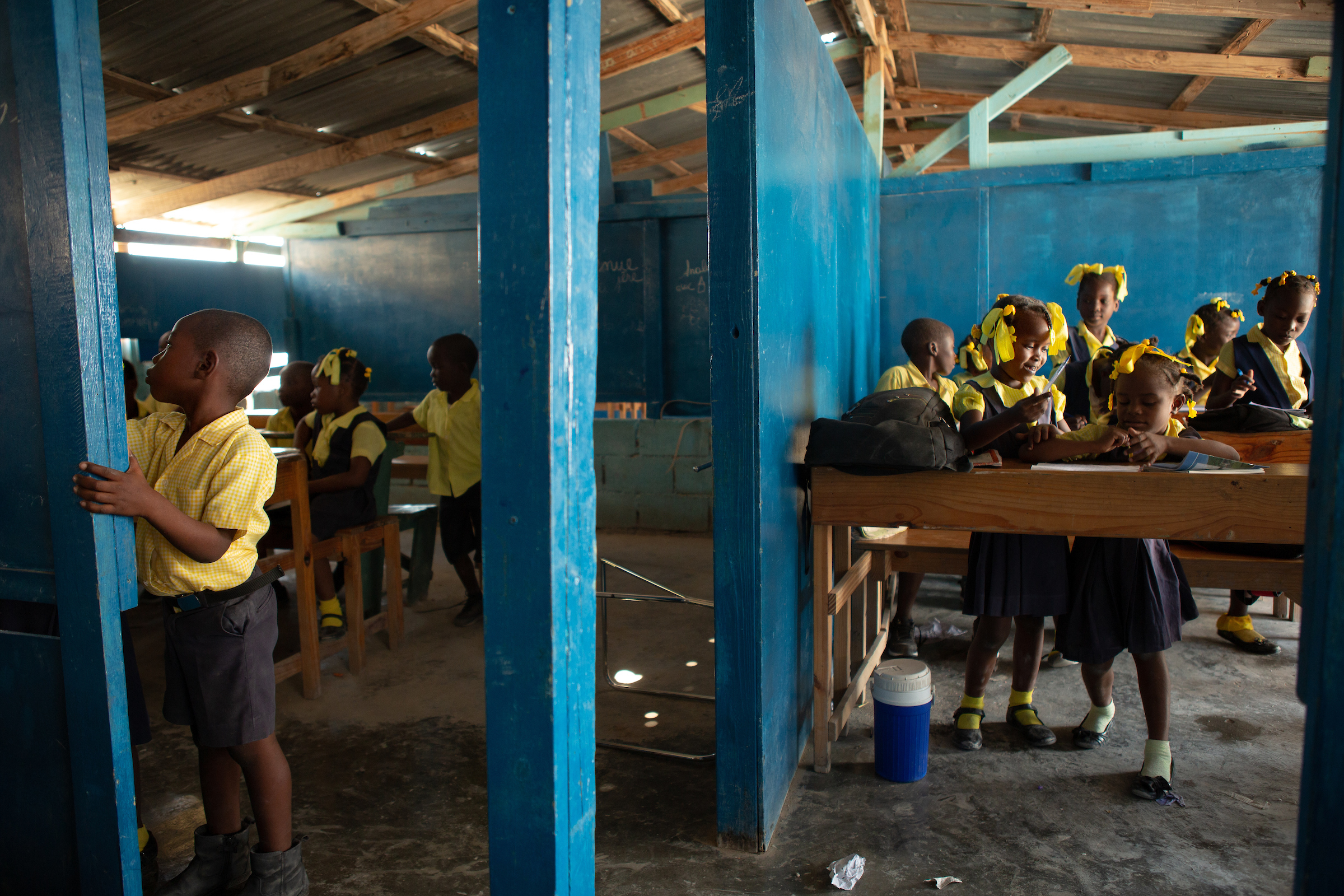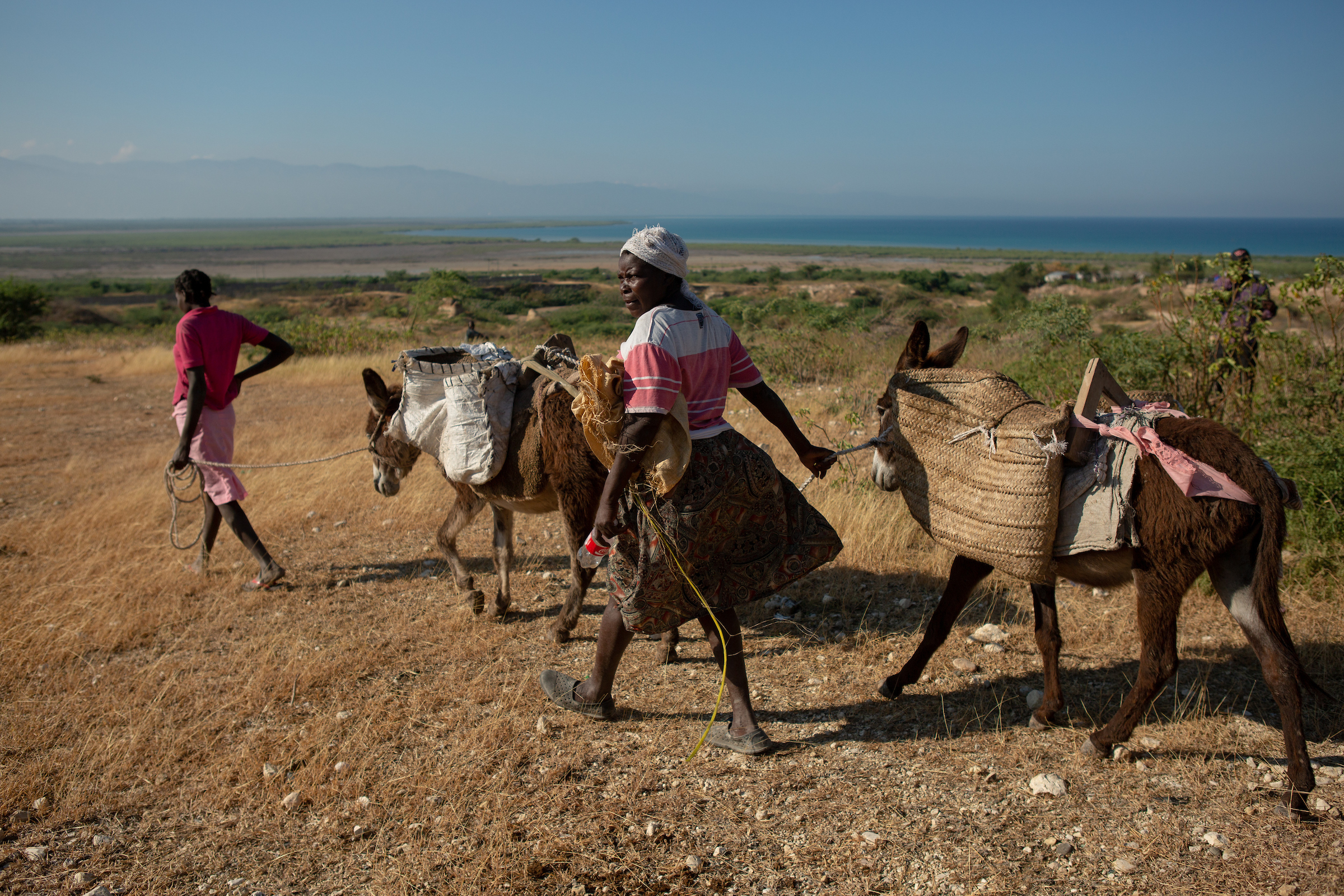This story was produced in collaboration with the Pulitzer Center on Crisis Reporting.
Approaching Titanyen from afar, the land’s unassuming beauty seems to overshadow its morbid past. Rough hills patched with grass are set against a backdrop of jagged mountains. Across from them lie the dark waters of the Caribbean Sea. In between, on a long-deserted stretch of land, a new city is taking shape.
Several miles north of Haiti’s capital, Port-au-Prince, Titanyen has long been a dumping ground for the bodies of people who fell out of favor with Haiti’s gangs, its political leaders, or anyone with a gun. Its name carries a menacing aura, with parents telling unruly children to shape up or they’ll send them to Titanyen.
When a 7.0-magnitude earthquake struck near Port-au-Prince in 2010, it sent the concrete floors of buildings toppling down upon one another, crushing people beneath. It sent mothers and fathers digging for their children, sent tens of thousands of people abruptly into early graves. Their bodies were buried by the thousands at Titanyen.
But a place with space for the dead is a place with space for the living, and in post-earthquake Haiti, space was in short supply. Only slightly larger than Vermont, Haiti is home to roughly 15 times as many people. Some 1.5 million of them—one out of every six Haitians—were displaced by the earthquake, and many were left homeless.
International non-governmental organizations (NGOs) began eyeing the vast stretch of vacant land east of Titanyen as a place to house them, and with the help of the United States Navy and the United Nations, they erected hundreds of small, temporary structures to house 7,500 people at a spot called Corail-Cesselesse. Haiti’s president used eminent domain to declare the land public, which Haitians took to mean free. Within days, people began flocking to the area around Corail, building shacks out of tarps and wood. Soon thousands of people were migrating north to this once-empty landscape, lying down bricks that would become the foundations of their future homes.
Haiti’s earthquake shattered several cities, but it also birthed another. Called Canaan, after the biblical holy land, a place defined by death has come alive.
One of Canaan’s early pioneers was a woman named Carmen Cean, who everybody knows as Madame Roy. The day the earthquake struck, Roy saw her Port-au-Prince neighborhood felled to ruins in an instant. “I felt a big thing like a big truck had run into my house,” Roy told me one morning at an empty Port-au-Prince restaurant down the road from where she’d been living at the time. “I ran out of the house, and I saw that my entire country was white. The dust! All the walls had fallen.”
The death toll of Haiti’s earthquake was wildly disproportionate to that of similar seismic events. In 1989, the Loma Prieta earthquake struck a similarly populated part of Northern California at almost precisely the same magnitude, killing 63 people. Haiti’s earthquake killed an estimated 46,000 to 316,000. No one knows exactly how many.

(Photo: Allison Shelley)
The difference between the two wasn’t natural, but political: Haitians had been kept poor and deprived of affordable safe housing by centuries of poor governance, often exacerbated by predatory foreign policy—much of which continues to this day.
That’s why Canaan presented such an unprecedented opportunity: space upon which people would “have more possibilities,” Roy says. “They can make their own little house. People never thought of that before.”
When Roy first visited to scope out the land, she found a group of fishermen and their children living in tents near the sea. She asked them what the area was called. Village du Pecheur, they replied—fisherman’s village.
“It’s a beautiful village that overlooks the ocean,” Roy says. Rather than sit back and wait for some NGO to build shelters, Roy consulted with an architect and began designing the new neighborhood herself. The morning we met, Roy unfolded one enormous architectural map after another onto a small table, the product of a topographical study she’d commissioned of the terrain.
Wearing a blue bow in her hair that matched her shirt, Roy, who is 53, has thin eyebrows and a single wrinkle on her forehead. She gestures grandiosely as speaks, leaning in close to place a finger on the spot she planned to build a gate, for security. She deferred to the architect as to where to place the roads, the houses, the cistern, the soccer field. But the primary school, set aspirationally upon the highest hilltop, was her own design.
To get started, Roy went around collecting money—500 gourdes, about $8—from each person who wanted a place in the city-to-be. Many were skeptical of the idea. But when Roy hired a tractor and set to work on the entry road, short and unpaved though it was, people took it as a sign that the land was indeed becoming something. And so, “they all came to take a little morsel of land for themselves.” Next to a graveyard, a neighborhood arose.

(Photo: Allison Shelley)
“When we arrived, we saw a land that had no trees,” Roy says. “And so we planted trees that would become big.” In Haiti, you don’t plant a seedling that will take years to bear fruit unless you think you’ll still be there when it does. In Canaan I found young trees growing everywhere. Two-hundred thousand people migrated to Canaan in the first two years of its existence, and the trees they planted signaled hope that they might live out the rest of their lives here, even pass the land down to their children. “I hope the whole village becomes full of trees,” Roy says.
Absent many formal jobs, residents opened businesses like barber shops and soda stands. Some are products of great imagination, like the workshop where one man makes dentures by hand. Canaan’s growth shows no signs of stopping. Despite the fact that most of the city still lacks basic services like electricity and water, residents take pride in what they’ve created on their own, largely without the help of their government.
“We planted our flag—not the national flag—our flag,” Roy says. To convey that “this is our village, that we discovered it.”
Within months of Canaan’s inception, NGOs began arriving, offering jobs on development projects. But the jobs were few and the competition was fierce, and sometimes power struggles arose. “We’re not saying that there’s never anyone who wants to throw a rock. That can happen. Men have imperfections,” Roy says. “But they can wake up at 10 or 11 the next day and help build a school.”

(Photo: Allison Shelley)
Less reliable are the outside forces that shape the city. Municipal governments in nearby districts are competing to levy taxes, claiming that the land falls under their jurisdiction. Meanwhile, Canaan’s settlements remain unrecognized by Haiti’s national government, and its residents enjoy few of the rights that their government bestows upon their fellow citizens: they can’t vote, and, without land titles, they don’t know for certain whether they’ll be allowed to stay. Whether Haiti’s government will resolve the question of the land’s original owner parcel out titles, thus bestowing rights upon the people squatting there remains to be seen.
“We already have unity,” Roy had told me the morning we’d met, speaking of the people who followed her toward Titanyen, hoping for a better life. “But will the state decide to invest in this population?”
“I don’t doubt that the state will accompany us,” Roy said. “But I haven’t seen it yet.”
Once, a few years back, Roy managed to amass 30,000 gourdes—about $400—to obtain a “Certificate of Occupation” from the local government of a nearby city, certifying that, legally or not, she and her school, her church, her community, existed—that they were present upon the land.
One year later, the only government recognition of her community’s existence had already expired.
Reporting for this story was funded by the Pulitzer Center on Crisis Reporting.







